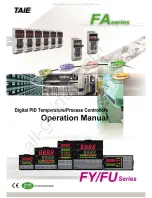
DL8000 Preset Instruction Manual
Revised February-2016
Modules
3-29
signals higher than the millivolt levels generated from a
thermocouple. The TC modules can reject common mode noise
(signals that are the same on both wires), but rejection is not perfect,
so minimize noise where possible.
Take care to properly shield thermocouple wiring from noise by
separating the thermocouple wiring runs from signals that are switching
loads and AC signals. Route wires away from noisy areas and twist the
two insulated leads of the thermocouple cable together to help ensure
both wires pickup the same noise. When operating in an extremely
noisy environment, use a shielded extension cable.
Caution
Shielded wiring is highly recommended. Ground shields only on one
end, preferably at the end device unless you have an excellent ground
system installed at the ROC800-series controller. Do not tie the
thermocouple module to ground.
Sheathed thermocouple probes are available with one of three junction
types: grounded, ungrounded, or exposed.
Figure 3-32. Ungrounded –
Sheathed
Figure 3-33. Grounded
Figure 3-34. Exposed,
Ungrounded – Unsheathed
In an
ungrounded
probe, the thermocouple junction is detached from
the probe wall. Response time slows down from the grounded style, but
the ungrounded probe offers electrical isolation of 1.5 M
Ω
at 500 Volts
dc in all diameters. The wiring may or may not be sheathed.
Note
:
Only
ungrounded
probes are supported. It is highly
recommended that you use sheathed probes.
Use an ungrounded junction for measurements in corrosive
environments where it is desirable to have the thermocouple
electronically isolated from and shielded by the sheath. The welded wire
thermocouple is physically insulated from the thermocouple sheath by
MgO powder (soft).
At the tip of a
grounded
junction probe, the thermocouple wires
physically attach to the inside of the probe wall. This results in good
heat transfer from the outside, through the probe wall to the
thermocouple junction. Grounded wiring is not supported.
The thermocouple in the
exposed
junction protrudes out of the tip of the
sheath and is exposed to the surrounding environment. This type offers
the best response time, but is limited in use to non-corrosive and non-
pressurized applications.
Exposed junction thermocouples are not
supported.
















































